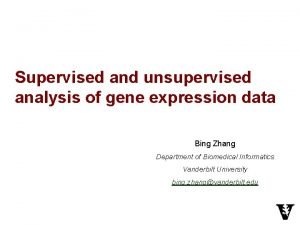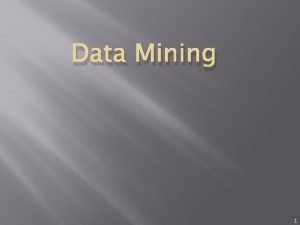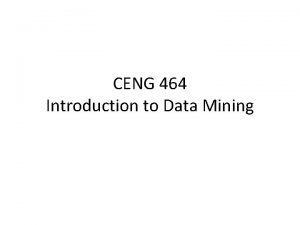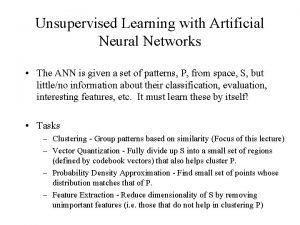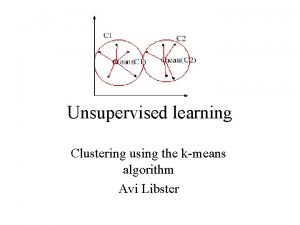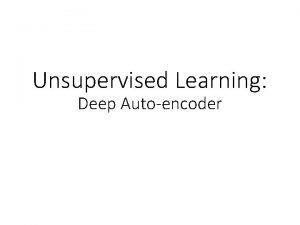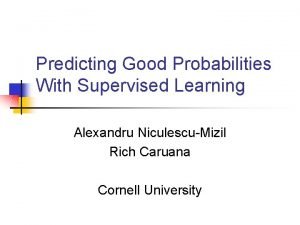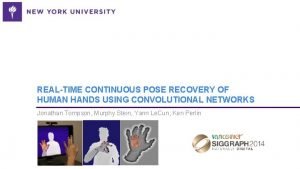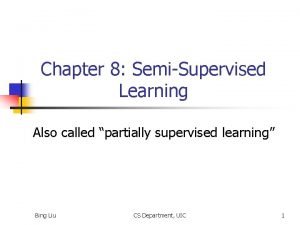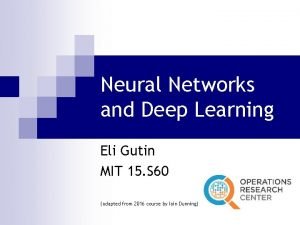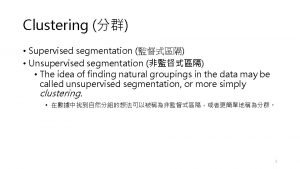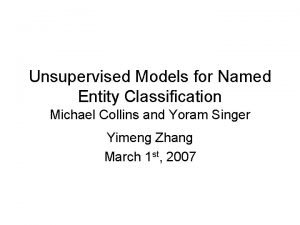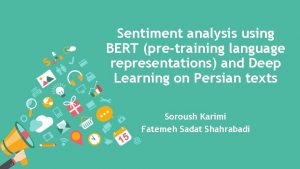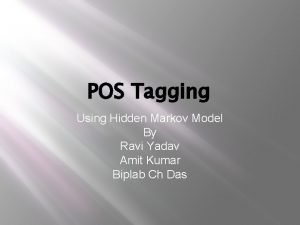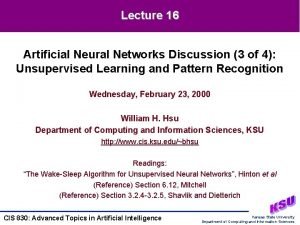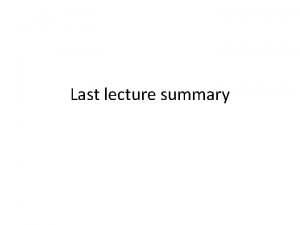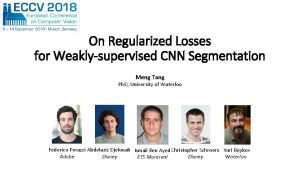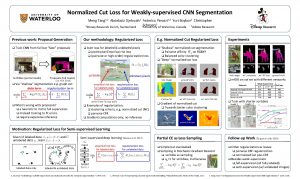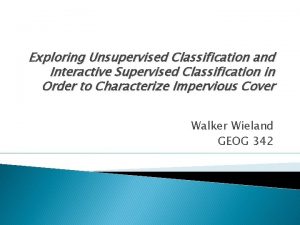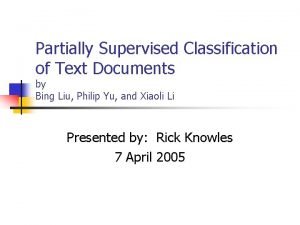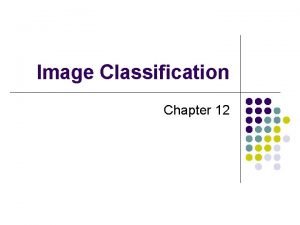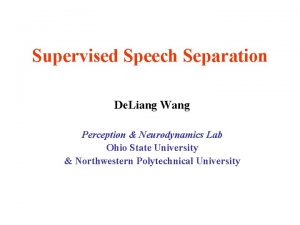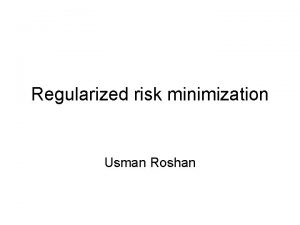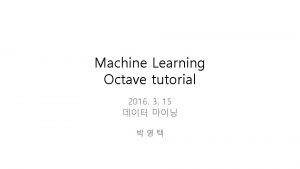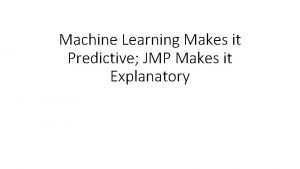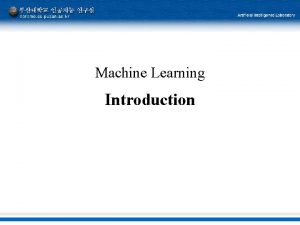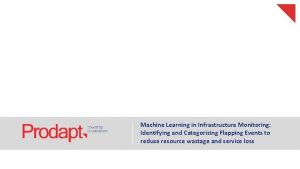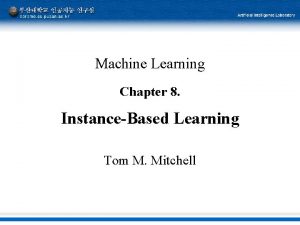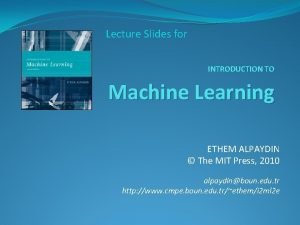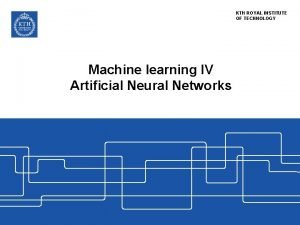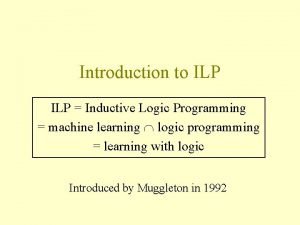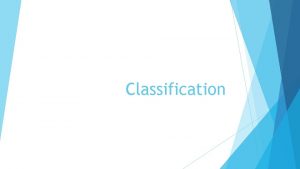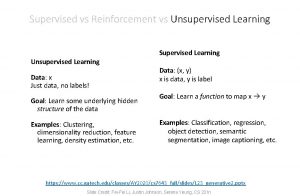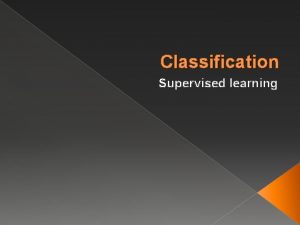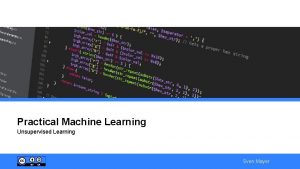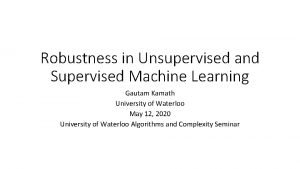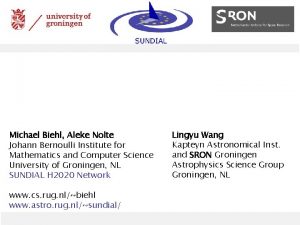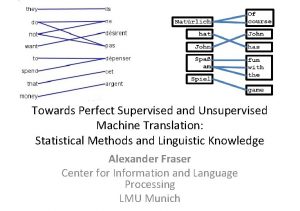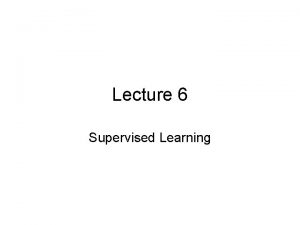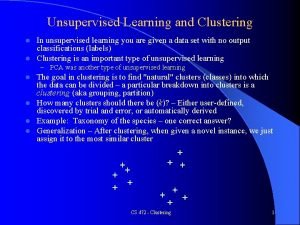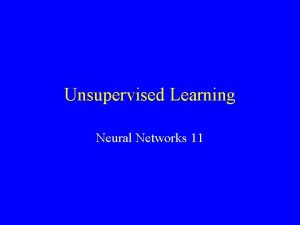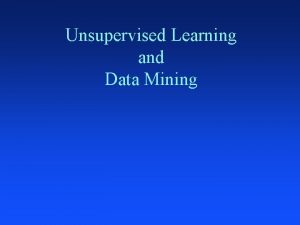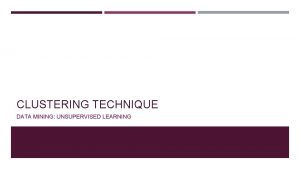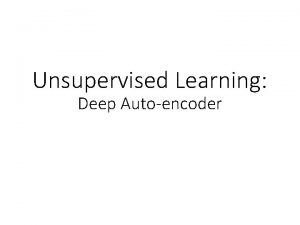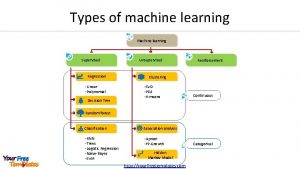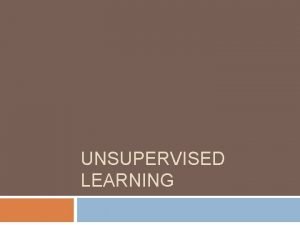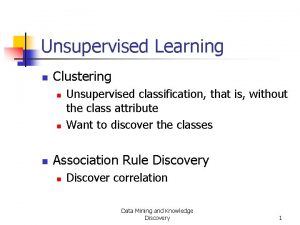Machine Learning Unsupervised Learning 1 Supervised learning vs











































































- Slides: 75

Machine Learning Unsupervised Learning 1

Supervised learning vs. unsupervised learning l Supervised learning: discover patterns in the data that relate data attributes with a target (class) attribute. l l These patterns are then utilized to predict the values of the target attribute in future data instances Unsupervised learning: The data have no target attribute. l We want to explore the data to find some intrinsic structures in them. 2

What is Cluster Analysis? l Finding groups of objects in data such that the objects in a group will be similar (or related) to one another and different from (or unrelated to) the objects in other groups Intra-cluster distances are minimized Inter-cluster distances are maximized 3

Applications of Cluster Analysis l Understanding l l Group related documents for browsing, group genes and proteins that have similar functionality, or group stocks with similar price fluctuations Summarization l Reduce the size of large data sets Clustering precipitation in Australia 4

Types of Clusterings l A clustering is a set of clusters l Important distinction between hierarchical and partitional sets of clusters l Partitional Clustering l l A division data objects into non-overlapping subsets (clusters) such that each data object is in exactly one subset Hierarchical clustering l A set of nested clusters organized as a hierarchical tree 5

Partitional Clustering (Bölümsel Kümeleme) Original Points A Partitional Clustering 6

Hierarchical Clustering (Hiyerarşik Kümeleme) Traditional Hierarchical Clustering Traditional Dendrogram Non-traditional Hierarchical Clustering Non-traditional Dendrogram 7

Clustering Algorithms l K-means and its variants l Hierarchical clustering l Density-based clustering 8

K-means clustering l l K-means is a partitional clustering algorithm Let the set of data points (or instances) D be {x 1, x 2, …, xn}, where xi = (xi 1, xi 2, …, xir) is a vector in a real-valued space X Rr, and r is the number of attributes (dimensions) in the data. l The k-means algorithm partitions the given data into k clusters. l l Each cluster has a cluster center, called centroid. k is specified by the user 9

K-means Clustering l Basic algorithm 10

Stopping/convergence criterion no (or minimum) re-assignments of data points to different clusters, no (or minimum) change of centroids, or minimum decrease in the sum of squared error (SSE), 1. 2. 3. l Ci is the jth cluster, mj is the centroid of cluster Cj (the mean vector of all the data points in Cj), and dist(x, mj) is the distance between data point x and centroid m j. 11

K-means Clustering – Details l Initial centroids are often chosen randomly. l l l The centroid is (typically) the mean of the points in the cluster. ‘Closeness’ is measured by Euclidean distance, cosine similarity, correlation, etc. K-means will converge for common similarity measures mentioned above. Most of the convergence happens in the first few iterations. l l Clusters produced vary from one run to another. Often the stopping condition is changed to ‘Until relatively few points change clusters’ Complexity is O( n * K * I * d ) l n = number of points, K = number of clusters, I = number of iterations, d = number of attributes 12

Two different K-means Clusterings Original Points Optimal Clustering Sub-optimal Clustering 13

Importance of Choosing Initial Centroids 14

Importance of Choosing Initial Centroids 15

Evaluating K-means Clusters l Most common measure is Sum of Squared Error (SSE) l For each point, the error is the distance to the nearest cluster l Given two clusters, we can choose the one with the smallest error One easy way to reduce SSE is to increase K, the number of clusters l A good clustering with smaller K can have a lower SSE than a poor clustering with higher K l 16

Importance of Choosing Initial Centroids 17

Importance of Choosing Initial Centroids 18

Problems with Selecting Initial Points l If there are K ‘real’ clusters then the chance of selecting one centroid from each cluster is small. l l l Chance is relatively small when K is large If clusters are the same size, n, then For example, if K = 10, then probability = 10!/1010 = 0. 00036 Sometimes the initial centroids will readjust themselves in ‘right’ way, and sometimes they don’t Consider an example of five pairs of clusters 19

10 Clusters Example Starting with two initial centroids in one cluster of each pair of clusters 20

10 Clusters Example Starting with two initial centroids in one cluster of each pair of clusters 21

10 Clusters Example Starting with some pairs of clusters having three initial centroids, while other have only one. 22

10 Clusters Example Starting with some pairs of clusters having three initial centroids, while other have only one. 23

Solutions to Initial Centroids Problem l Multiple runs l l l Sample and use hierarchical clustering to determine initial centroids Select more than k initial centroids and then select among these initial centroids l l l Helps, but probability is not on your side Select most widely separated Postprocessing Bisecting K-means 24

Pre-processing and Post-processing l Pre-processing l l l Normalize the data Eliminate outliers Post-processing l l Eliminate small clusters that may represent outliers Split ‘loose’ clusters, i. e. , clusters with relatively high SSE Merge clusters that are ‘close’ and that have relatively low SSE Can use these steps during the clustering process l ISODATA 25

Limitations of K-means l K-means has problems when clusters are of differing l l Sizes Densities Non-globular shapes K-means has problems when the data contains outliers. 26

Limitations of K-means: Differing Sizes Original Points K-means (3 Clusters) 27

Limitations of K-means: Differing Density Original Points K-means (3 Clusters) 28

Limitations of K-means: Non-globular Shapes Original Points K-means (2 Clusters) 29

Overcoming K-means Limitations Original Points K-means Clusters One solution is to use many clusters. Find parts of clusters, but need to put together. 30

Overcoming K-means Limitations Original Points K-means Clusters 31

Overcoming K-means Limitations Original Points K-means Clusters 32

Hierarchical Clustering l l Produces a set of nested clusters organized as a hierarchical tree Can be visualized as a dendrogram l A tree like diagram that records the sequences of merges or splits 33

Strengths of Hierarchical Clustering l Do not have to assume any particular number of clusters l l Any desired number of clusters can be obtained by ‘cutting’ the dendogram at the proper level They may correspond to meaningful taxonomies l Example in biological sciences (e. g. , animal kingdom, phylogeny reconstruction, …) 34

Hierarchical Clustering l l Two main types of hierarchical clustering l Agglomerative: l Start with the points as individual clusters l At each step, merge the closest pair of clusters until only one cluster (or k clusters) left l Divisive: l Start with one, all-inclusive cluster l At each step, split a cluster until each cluster contains a point (or there are k clusters) Traditional hierarchical algorithms use a similarity or distance matrix l Merge or split one cluster at a time 35

Agglomerative Clustering Algorithm l More popular hierarchical clustering technique l Basic algorithm is straightforward 1. 2. 3. 4. 5. 6. l Compute the proximity matrix Let each data point be a cluster Repeat Merge the two closest clusters Update the proximity matrix Until only a single cluster remains Key operation is the computation of the proximity of two clusters l Different approaches to defining the distance between clusters distinguish the different algorithms 36

Starting Situation l Start with clusters of individual points and a proximity matrix p 1 p 2 p 3 p 4 p 5 . . . p 1 p 2 p 3 p 4 p 5. . . Proximity Matrix 37

Intermediate Situation l After some merging steps, we have some clusters C 1 C 2 C 3 C 4 C 5 Proximity Matrix C 1 C 2 C 5 38

Intermediate Situation l We want to merge the two closest clusters (C 2 and C 5) and update the proximity matrix. C 1 C 2 C 3 C 4 C 5 Proximity Matrix C 1 C 2 C 5 39

After Merging l The question is “How do we update the proximity matrix? ” C 1 C 2 U C 5 C 3 C 4 ? ? ? C 3 ? C 4 ? Proximity Matrix C 1 C 2 U C 5 40

How to Define Inter-Cluster Similarity p 1 Similarity? p 2 p 3 p 4 p 5 . . . p 1 p 2 p 3 p 4 l l l p 5 MIN. MAX. Group Average. Distance Between Centroids Other methods driven by an objective function l Proximity Matrix Ward’s Method uses squared error 41

How to Define Inter-Cluster Similarity p 1 p 2 p 3 p 4 p 5 . . . p 1 p 2 p 3 p 4 l l l p 5 MIN. MAX. Group Average. Distance Between Centroids Other methods driven by an objective function l Proximity Matrix Ward’s Method uses squared error 42

How to Define Inter-Cluster Similarity p 1 p 2 p 3 p 4 p 5 . . . p 1 p 2 p 3 p 4 l l l p 5 MIN. MAX. Group Average. Distance Between Centroids Other methods driven by an objective function l Proximity Matrix Ward’s Method uses squared error 43

How to Define Inter-Cluster Similarity p 1 p 2 p 3 p 4 p 5 . . . p 1 p 2 p 3 p 4 l l l p 5 MIN. MAX. Group Average. Distance Between Centroids Other methods driven by an objective function l Proximity Matrix Ward’s Method uses squared error 44

How to Define Inter-Cluster Similarity p 1 p 2 p 3 p 4 p 5 . . . p 1 p 2 p 3 p 4 l l l p 5 MIN. MAX. Group Average. Distance Between Centroids Other methods driven by an objective function l Proximity Matrix Ward’s Method uses squared error 45

Cluster Similarity: MIN or Single Link l Similarity of two clusters is based on the two most similar (closest) points in the different clusters l Determined by one pair of points, i. e. , by one link in the proximity graph. 1 2 3 4 5 46

Hierarchical Clustering: MIN 1 3 5 2 1 2 3 4 5 6 4 Nested Clusters Dendrogram 47

Strength of MIN Original Points Two Clusters • Can handle non-elliptical shapes 48

Limitations of MIN Original Points Two Clusters • Sensitive to noise and outliers 49

Cluster Similarity: MAX or Complete Linkage l Similarity of two clusters is based on the two least similar (most distant) points in the different clusters l Determined by all pairs of points in the two clusters 1 2 3 4 5 50

Strength of MAX Original Points Two Clusters • Less susceptible to noise and outliers 51

Limitations of MAX Original Points Two Clusters • Tends to break large clusters • Biased towards globular clusters (globular -- küresel) 52

Cluster Similarity: Group Average l Proximity of two clusters is the average of pairwise proximity between points in the two clusters. l Need to use average connectivity for scalability since total proximity favors large clusters 1 2 3 4 5 53

Hierarchical Clustering: Group Average 5 4 1 2 5 2 3 6 1 4 3 Nested Clusters Dendrogram 54

Hierarchical Clustering: Group Average l Compromise between Single and Complete Link l Strengths l l Less susceptible to noise and outliers Limitations l Biased towards globular (küresel) clusters 55

Cluster Similarity: Ward’s Method l Similarity of two clusters is based on the increase in squared error when two clusters are merged l Similar to group average if distance between points is distance squared l Less susceptible to noise and outliers l Biased towards globular clusters l Hierarchical analogue of K-means l Can be used to initialize K-means 56

Cluster Validity l For supervised classification we have a variety of measures to evaluate how good our model is l Accuracy, precision, recall l For cluster analysis, the analogous question is how to evaluate the “goodness” of the resulting clusters? l But “clusters are in the eye of the beholder”! l Then why do we want to evaluate them? l l To avoid finding patterns in noise To compare clustering algorithms To compare two sets of clusters To compare two clusters 57

Clusters found in Random Data Random Points K-means DBSCAN Complete Link 58

Different Aspects of Cluster Validation 1. 2. 3. 4. 5. Determining the clustering tendency of a set of data, i. e. , distinguishing whether non-random structure actually exists in the data. Comparing the results of a cluster analysis to externally known results, e. g. , to externally given class labels. Evaluating how well the results of a cluster analysis fit the data without reference to external information. - Use only the data Comparing the results of two different sets of cluster analyses to determine which is better. Determining the ‘correct’ number of clusters. For 2, 3, and 4, we can further distinguish whether we want to evaluate the entire clustering or just individual clusters. 59

Measures of Cluster Validity l Numerical measures that are applied to judge various aspects of cluster validity, are classified into the following three types. l External Index: Used to measure the extent to which cluster labels match externally supplied class labels. l l Internal Index: Used to measure the goodness of a clustering structure without respect to external information. l l Sum of Squared Error (SSE) Relative Index: Used to compare two different clusterings or clusters. l l Entropy Often an external or internal index is used for this function, e. g. , SSE or entropy Sometimes these are referred to as criteria instead of indices l However, sometimes criterion is the general strategy and index is the numerical measure that implements the criterion. 60

Measuring Cluster Validity Via Correlation l Two matrices l l Proximity Matrix (Yakınlık matrisi) “Incidence” Matrix (Tekrar Oranı Matrisi) l l Compute the correlation between the two matrices l l l One row and one column for each data point An entry is 1 if the associated pair of points belong to the same cluster An entry is 0 if the associated pair of points belongs to different clusters Since the matrices are symmetric, only the correlation between n(n-1) / 2 entries needs to be calculated. High correlation indicates that points that belong to the same cluster are close to each other. Not a good measure for some density or contiguity based clusters. 61

Measuring Cluster Validity Via Correlation l Correlation of incidence and proximity matrices for the K-means clusterings of the following two data sets. Corr = -0. 9235 Corr = -0. 5810 62

Using Similarity Matrix for Cluster Validation l Order the similarity matrix with respect to cluster labels and inspect visually. 63

Using Similarity Matrix for Cluster Validation l Clusters in random data are not so crisp DBSCAN 64

Using Similarity Matrix for Cluster Validation l Clusters in random data are not so crisp K-means 65

Using Similarity Matrix for Cluster Validation l Clusters in random data are not so crisp Complete Link 66

Using Similarity Matrix for Cluster Validation DBSCAN 67

Internal Measures: Cohesion and Separation l Cluster Cohesion: Measures how closely related are objects in a cluster l Example: SSE l Cluster Separation: Measure how distinct or wellseparated a cluster is from other clusters l Example: Squared Error l Cohesion is measured by the within cluster sum of squares (SSE) l Separation is measured by the between cluster sum of squares § Where |Ci| is the size of cluster i 68

Extra 69

Hierarchical Clustering: Comparison 1 3 5 5 1 2 3 6 MIN MAX 5 2 5 1 5 Ward’s Method 3 6 4 1 2 5 2 Group Average 3 1 4 6 4 2 3 3 3 2 4 5 4 1 5 1 2 2 4 4 6 1 4 3 70

Internal Measures: SSE l Clusters in more complicated figures aren’t well separated l Internal Index: Used to measure the goodness of a clustering structure without respect to external information l l l SSE is good for comparing two clusterings or two clusters (average SSE). Can also be used to estimate the number of clusters 71

Internal Measures: SSE l SSE curve for a more complicated data set SSE of clusters found using K-means 72

Framework for Cluster Validity l Need a framework to interpret any measure. l l For example, if our measure of evaluation has the value, 10, is that good, fair, or poor? Statistics provide a framework for cluster validity l l The more “atypical” a clustering result is, the more likely it represents valid structure in the data Can compare the values of an index that result from random data or clusterings to those of a clustering result. l l l If the value of the index is unlikely, then the cluster results are valid These approaches are more complicated and harder to understand. For comparing the results of two different sets of cluster analyses, a framework is less necessary. l However, there is the question of whether the difference between two index values is significant 73

Statistical Framework for SSE l Example l l Compare SSE of 0. 005 against three clusters in random data Histogram shows SSE of three clusters in 500 sets of random data points of size 100 distributed over the range 0. 2 – 0. 8 for x and y values 74

Statistical Framework for Correlation l Correlation of incidence and proximity matrices for the K-means clusterings of the following two data sets. Corr = -0. 9235 Corr = -0. 5810 75
 Lda supervised or unsupervised
Lda supervised or unsupervised Jelaskan perbedaan unsupervised dan supervised learning
Jelaskan perbedaan unsupervised dan supervised learning Deep reinforcement learning example
Deep reinforcement learning example Supervised and unsupervised learning
Supervised and unsupervised learning Supervised vs unsupervised data mining
Supervised vs unsupervised data mining Supervised vs unsupervised data mining
Supervised vs unsupervised data mining Unsupervised learning in data mining
Unsupervised learning in data mining Transductive learning for unsupervised text style transfer
Transductive learning for unsupervised text style transfer Autoencoders, unsupervised learning, and deep architectures
Autoencoders, unsupervised learning, and deep architectures Ann unsupervised learning
Ann unsupervised learning Is pca unsupervised learning
Is pca unsupervised learning Unsupervised learning
Unsupervised learning Andrew ng introduction to machine learning
Andrew ng introduction to machine learning Contractive autoencoder
Contractive autoencoder Alexandru niculescu-mizil
Alexandru niculescu-mizil Supervised learning pipeline
Supervised learning pipeline Partially supervised learning
Partially supervised learning Deep q network
Deep q network Victor lempitsky
Victor lempitsky Unsupervised segmentation
Unsupervised segmentation Iso cluster unsupervised classification
Iso cluster unsupervised classification Unsupervised models for named entity classification
Unsupervised models for named entity classification Nbsvm
Nbsvm Unsupervised pos tagging
Unsupervised pos tagging The wake-sleep algorithm for unsupervised neural networks
The wake-sleep algorithm for unsupervised neural networks Unsupervised hierarchical clustering
Unsupervised hierarchical clustering Oren freifeld
Oren freifeld Normalized cut loss for weakly-supervised cnn segmentation
Normalized cut loss for weakly-supervised cnn segmentation Normalized cut loss for weakly-supervised cnn segmentation
Normalized cut loss for weakly-supervised cnn segmentation Bruce a research chemist for a major petro
Bruce a research chemist for a major petro Supervised diversionary program
Supervised diversionary program Interactive supervised classification
Interactive supervised classification Supervised visitation center dc
Supervised visitation center dc Sae project ideas with animals
Sae project ideas with animals Partially supervised classification of text documents
Partially supervised classification of text documents Supervised agricultural experience definition
Supervised agricultural experience definition Supervised classification
Supervised classification Process
Process On training targets for supervised speech separation
On training targets for supervised speech separation Concept learning task in machine learning
Concept learning task in machine learning Analytical learning in machine learning
Analytical learning in machine learning Pac learning model in machine learning
Pac learning model in machine learning Machine learning t mitchell
Machine learning t mitchell Inductive and analytical learning
Inductive and analytical learning Inductive analytical approach to learning
Inductive analytical approach to learning Instance based learning in machine learning
Instance based learning in machine learning Inductive learning machine learning
Inductive learning machine learning First order rule learning in machine learning
First order rule learning in machine learning Lazy learners vs eager learner
Lazy learners vs eager learner Cmu machine learning
Cmu machine learning Finite state machine vending machine example
Finite state machine vending machine example Mealy or moore machine
Mealy or moore machine Moore machine to mealy machine
Moore machine to mealy machine Ma=fr/fe
Ma=fr/fe Cuadro comparativo de e-learning b-learning y m-learning
Cuadro comparativo de e-learning b-learning y m-learning Bsp classification
Bsp classification Expected risk minimization
Expected risk minimization Microsoft sql server machine learning services
Microsoft sql server machine learning services Azure machine learning studio logo
Azure machine learning studio logo Octave programming tutorial
Octave programming tutorial Jmp pca
Jmp pca Tom mitchell cmu
Tom mitchell cmu Machine learning infrastructure monitoring
Machine learning infrastructure monitoring Valerie du preez
Valerie du preez Jasjeet thind
Jasjeet thind Tom mitchell machine learning solutions chapter 3
Tom mitchell machine learning solutions chapter 3 Ethem alpaydin
Ethem alpaydin Version space learning
Version space learning Kth machine learning
Kth machine learning Andrew ng introduction to machine learning
Andrew ng introduction to machine learning Hypothesis space in machine learning
Hypothesis space in machine learning Ilp machine learning
Ilp machine learning User behavior analytics qradar
User behavior analytics qradar Xkcd image recognition
Xkcd image recognition Avoiding discrimination through causal reasoning
Avoiding discrimination through causal reasoning Bagging boosting and stacking
Bagging boosting and stacking



